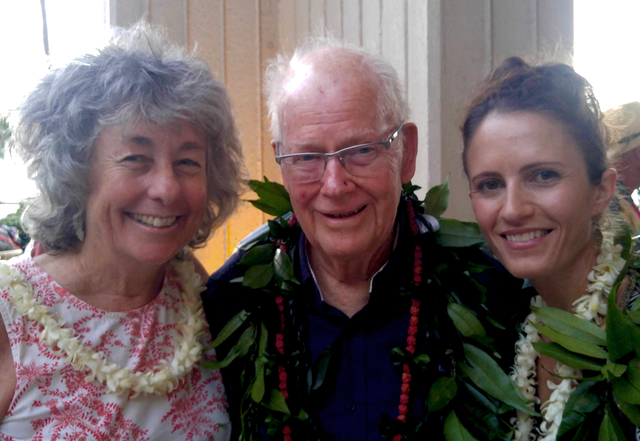Kahua Ranch’s living journal

KAMUELA — Released earlier this month, “Ranching Under the Rainbow,” provides another window into the history of the Big Island with the story of Kahua Ranch and its stewards, the Atherton Richards and Von Holt families. It’s the latest in a series of publications produced through the efforts of Faye Mitchell’s Living Journals project and North Kohala Community Resource Center (NKCRC).
The book really began when Faye Mitchell, who grew up in Kohala, returned to the community.
“People can live here for a very long time and not actually know about the underlying history, because the communication hasn’t happened or the connections haven’t been made with the older community,” she realized.
Mitchell set out to make those connections — a process of discovery that has added much to the written history of Kohala — with each new story enlivening the rich historical tapestry of Kohala.
“When Faye came to us with this project, it was really a good fit for our broad-based mission to sponsor projects that benefit the North Kohala community,” said Christine Richardson, NKCRC’s director. “This project has benefits on so many levels: cultural history, personal relationships, documenting and holding our community’s history.”
Since its inception, Mitchell and Living Journals has produced four small oral history narrative books of Kohala natives and two longer autobiographical works, “A Storyteller’s Story: Kindy Sproat of North Kohala” and the new release.
“For the Love of the Land,” a series of oral history interviews with Nan Pi’ianaia published in 2006, was written by Kahua Ranch’s chairman and trustee, Monty Richards. When the Kindy Sproat book emerged, he was inspired to create a narrative of his own story.
“This oral history project began with a phone call from Monty as he held the Sproat book in his hands,” said Mitchell. “It inspired him to record this book. He was an old buddy of Kindy’s.”
During about 20 visits resulting in 30 hours of recordings, Mitchell worked with Richards to create a lively narrative enhanced with news clippings and photos that depict 20th century Hawaii ranching life. The authentic voice that comes through is a reflection of Hawaiian style interviews.
“It’s really just talk story — how things come out in our community when people are sitting down having coffee and eating,” Mitchell said. “We would have lunch in the kitchen and go walk around the grounds, all the time recording.”
After the recordings were transcribed, “I’d go visit with them (the family) and pour through all the transcripts. Half the stories come in at that point — a process of revisiting and revisiting and then new connections come up,” said Mitchell. “It’s not only the interviewee that is helping to edit it, it’s a family member as well. His wife, Ellie, had a big part in that, as well as his daughter, Pam, who read through and contributed photos.”
Born in Kohala in 1929, Richards’ story begins with the drought and Depression that sent his family to Honolulu.
“(Father) didn’t mind diapers being washed as long as we had water, but with the drought when we were out of water, he could not see using all the okolehao (liquor) to wash the diapers,” he remembered on page 23 in the book.
Richards paints a picture of his childhood years in Honolulu at Punahou School, riding the “HRT, Honolulu Rapid Transit, as it was called in those days,” he said.
And how he learned to swim.
“So, they had Sarge Kahanamoku be my teacher. That was Duke’s brother. ‘Just get in the water,’ he’d say and let the waves crash over you. You go under water — too bad! But that’s how I learned to swim,” Richards said.
His idyllic childhood was interrupted by WWII. Martial law meant carrying gas masks and your papers at all times.
“You mind your p’s and q’s, and when the air raid sirens would go off — and we had a lot of air raid sirens — the buses would stop, they’d open the doors and you would go to the nearest shelter,” Richards recalled on page 28.
While living in Honolulu, he maintained his connection to Kahua with many visits.
“I recall one trip very vividly where he (Ronald von Holt) picked me up at Mahukona at about 10 o’clock at night off the Humu’ula. You’d come in by ‘lighter’ (small boat) and at times it’s too rough, so they get as close as they can. Then a crew guy grabs you and pitches you along with your baggage,” Richards remembered.
In 1955, he was sent to be an assistant to Rally Greenwell, then the manager at Kahua Ranch. This began his education in the ranching life and through his shared experiences, readers are treated to an insider’s view of Big Island ranches and the larger-than-life people who ran them.
Richards also shares his understanding of land and natural resource management, gained through 60 years of coping with an array of challenges such as water use, disease, pasture management and sustainable energy production, making the book a useful resource as well as an engaging read.
Mitchell said the book has a wide appeal for, “People who are in ranching, or people who live in the area and have heard of Monty and Kahua. They really don’t know the land they’re living on and what the story is behind it. It’s also for people who just live in the area and want to have a better sense for history in general, and for visitors who want to know more.”
Through Living Journals, Mitchell has been able to take that raw oral history format and turn it into something more readable.
“The goal for me is to make sure connections happen,” she said.
With connections to the past and the island community in which we thrive, “Ranching Under the Rainbow” has made a big contribution to that endeavor.
Info: The book can be ordered online at www.northkohala.org/online-store/


